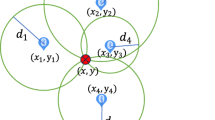Abstract
This paper presents an analysis of the received signal strength indicator (RSSI) from the radio frequency signals for human identification in an indoor wireless sensor network (WSN). Instead of using closed-circuit television as the existing security platform, this indoor safety system was improved with a convenient, cheap, and low-power solution. The system was developed using 20 of ESP8266-12F Wi-Fi modules transmitters and another 2 of ESP8266-12F as the access points located in 3 m × 3 m area of interest. With a suitable coordinate of sensor nodes, a WSN telemetry could be established to minimize the blind spot area and limit the movement of the intruder with a minimum area of 0.2 m2. The RSSI measurement was repeatedly conducted for three different conditions, in an empty room, with the presence of a single intruder and the presence of multiple intruders. Based on the RSSI values, we found that there are distinctive features of data that can be utilized as flags for classifying the three above conditions. Besides that, to justify the efficiency of system performance, we also examined the sensitivity of RSSI values towards the variation of temperature. Our results show that the RSSI average values for both morning and night were practically the same. However, during the afternoon, the RSSI signal strength fluctuated by − 1.0 dBm. These results motivate the development of an alarm system that only uses the RSSI statistics to detect human presence.















Similar content being viewed by others
References
Thaolang L (2016) Project charter for CCTV camera installation at BIUST administration block [Online]. https://www.researchgate.net/publication/307577795_Project_charter_for_CCTV_camera_installation_at_BIUST_administration_block. Revised 20 Oct 2019
Pikaar R, Lenior D, Schreibers K, De Bruijn D (2015) Human factors guidelines for CCTV system design. In: Proc.—Trienn. Congr. IEA, no. August, pp 1–8
Hu G (2016) Study on the signal transmission characteristics of 2.4 GHz wireless network in dorms. Int J Online Eng 12(10):58–63
Ali MM, Habaebi MH, Aliasaa NA, Islam MR, Hameed SA (2015) Characterization of RF signal behavior for the use in indoor human presence detection. ARPN J Eng Appl Sci 10(21):9669–9674
Pirzada N, Nayan MY, Subhan F, Hassan MF, Khan MA (2014) Device-free localization technique for indoor detection and tracking of human body: a survey. Procedia Soc Behav Sci 129(2014):422–429. https://doi.org/10.1016/j.sbspro.2014.03.696
Klogo GS, Gadze JD (2013) Energy constraints of localization techniques in wireless sensor networks (WSN): a survey. Int J Comput Appl 75(9):44–52
Oguejiofor OS, Okorogu VN, Abe A, Osuesu BO (2013) Outdoor localization system using RSSI measurement of wireless sensor network. Int J Innov Technol Explor Eng 2(2):1–6
Habaebi M, Rosli R, Islam MR (2017) RSSI-based human presence detection system for energy saving automation. Indones J Electr Eng Informat 5(4):339–350. https://doi.org/10.11591/ijeei.v5i4.356
Habaebi MH et al (2015) Development of physical intrusion detection system using Wi-Fi/ZigBee RF signals. Procedia Comput Sci 76:547–552. https://doi.org/10.1016/j.procs.2015.12.342
Singh KYR, Singh P (2014) Wireless communications enlargement: a review of advancement in technologies. Int J Curr Eng Technol 4(4):2703–2710. https://doi.org/10.13140/rg.2.1.3024.0242
Danbatta SJ, Varol A (2011) Comparison of Zigbee, Z-Wave, Wi-Fi, and bluetooth wireless technologies used in home automation. In: 7th Int. Symp. Digit. Forensics Secur. ISDFS 2019, pp 1–5, 2019. https://doi.org/10.1109/ISDFS.2019.8757472
Kazeem OO, Akintade OO, Kehinde LO (2017) Comparative study of communication interfaces for sensors and actuators in the cloud of Internet of Things. Int J Internet Things 6(1):9–13. https://doi.org/10.5923/j.ijit.20170601.02
A.-T S (2018) Technology, “ESP12-F Datasheet,” 2018. [Online]. https://www.ai-thinker.com. Accessed 29 May 2020
Boukar AJ, Daeri AM, Alqusbi E (2017) Effect of antenna height and distance on attenuation for point to point wave propagation. In: 4th Int. Conf. Control Eng. Inf. Technol. CEIT 2016, no. December, pp 16–18, 2017. https://doi.org/10.1109/CEIT.2016.7929110
Xu L, Yang F, Jiang Y, Zhang L, Feng C, Bao N (2011) Variation of received signal strength in wireless sensor network. In: 2011 3rd int. conf. adv. comput. control, no. Icacc, pp 151–154, 2011. https://doi.org/10.1109/icacc.2011.6016387
Guidara A, Fersi G, Derbel F, Ben Jemaa M (2018) Impacts of temperature and humidity variations on RSSI in indoor wireless sensor networks. In: 22nd int. conf. knowledge-based intell. information& eng. syst., vol 126, pp 1072–1081. https://doi.org/10.1016/j.procs.2018.08.044
Sabu S, Renimol S, Abhiram D, Premlet B (2017) A study on the effect of temperature on cellular. In: Int. conf. nextgen electron. technol. silicon to softw. 2017, pp 38–41. https://doi.org/10.1109/icnets2.2017.8067893
Luomala J, Hakala I (2015) Effects of temperature and humidity on radio signal strength in outdoor wireless sensor networks. In: Proc. 2015 fed. conf. comput. sci. Inf. Syst., vol. 5, pp 1247–1255. https://doi.org/10.15439/2015f241
Acknowledgements
The authors would like to acknowledge the support from the Transdisciplinary Research Grant Scheme (TRGS) under grant number of TRGS/1/2018/UNIMAP/02/4/2 from the Ministry of Higher Education Malaysia. The authors would also gratefully thank Universiti Malaysia Perlis, Malaysia for the facilities and technical assistance.
Author information
Authors and Affiliations
Corresponding author
Additional information
Publisher's Note
Springer Nature remains neutral with regard to jurisdictional claims in published maps and institutional affiliations.
Rights and permissions
About this article
Cite this article
Ramli, N.A.M., Rahiman, M.H.F., Malik, M.F.A. et al. A Design and Development of a Wireless Sensor Network for Potential Monitoring and Localization. J. Electr. Eng. Technol. 15, 2735–2743 (2020). https://doi.org/10.1007/s42835-020-00515-5
Received:
Revised:
Accepted:
Published:
Issue Date:
DOI: https://doi.org/10.1007/s42835-020-00515-5




